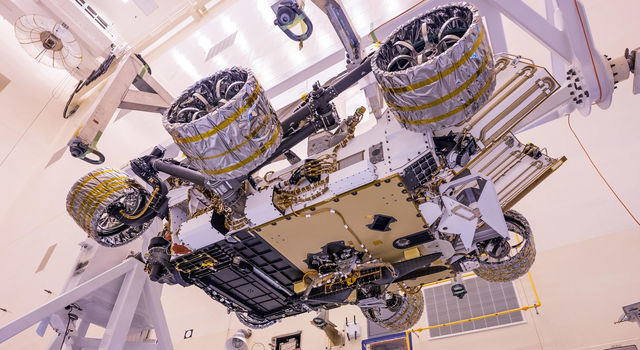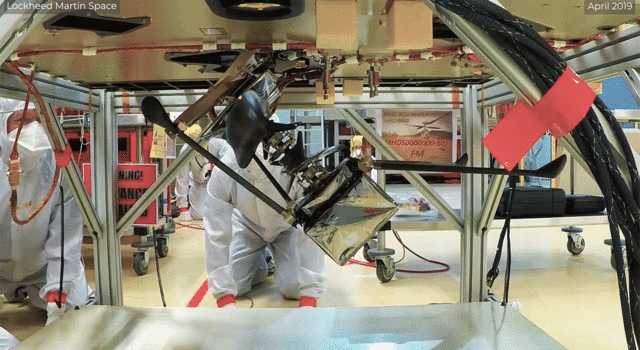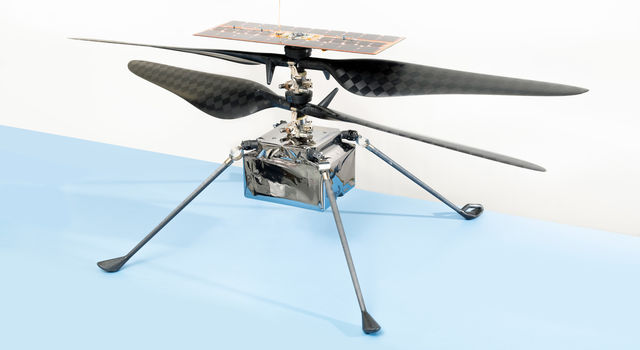31.05.2020
The Detective Aboard NASA's Perseverance Rover
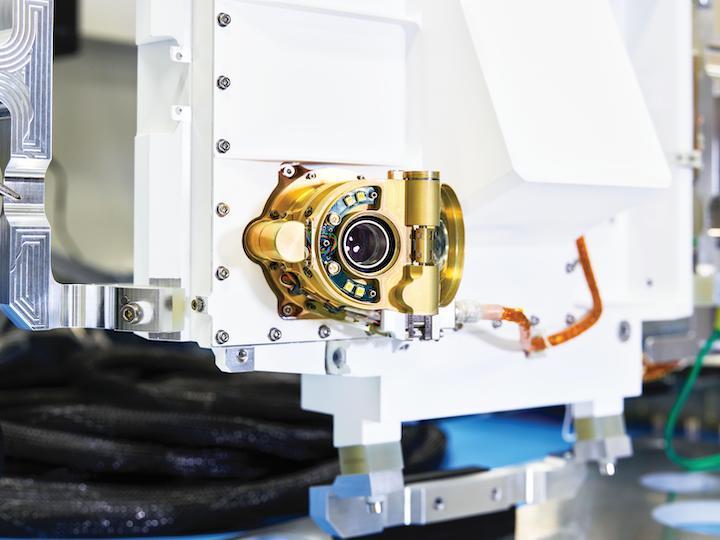
A close-up view of an engineering model of SHERLOC (Scanning Habitable Environments with Raman & Luminescence for Organics & Chemicals), one the instruments aboard NASA's Perseverance Mars rover. Located on the end of the rover's robotic arm, this instrument features an auto-focusing camera (pictured) that shoots black-and-white images used by SHERLOC's color camera, called WATSON (Wide Angle Topographic Sensor for Operations and eNgineering), to zero in on rock textures. SHERLOC also has a laser, which aims for the dead center of rock surfaces depicted in WATSON's images.
The laser uses a technique called Raman spectroscopy to detect minerals in microscopic rock features; that data is then superimposed on WATSON's images. These mineral maps help scientists determine which rock samples Perseverance should drill so that they can be sealed in metal tubes and left on the Martian surface for a future mission to return to Earth.
-
An instrument called SHERLOC will, with the help of its partner WATSON, hunt for signs of ancient life by detecting organic molecules and minerals.
Mars is a long way from 221B Baker Street, but one of fiction's best-known detectives will be represented on the Red Planet after NASA's Perseverance rover touches down on Feb. 18, 2021. SHERLOC, an instrument on the end of the rover's robotic arm, will hunt for sand-grain-sized clues in Martian rocks while working in tandem with WATSON, a camera that will take close-up pictures of rock textures. Together, they will study rock surfaces, mapping out the presence of certain minerals and organic molecules, which are the carbon-based building blocks of life on Earth.
SHERLOC was built at NASA's Jet Propulsion Laboratory in Southern California, which leads the Perseverance mission; WATSON was built at Malin Space Science Systems in San Diego. For the most promising rocks, the Perseverance team will command the rover to take half-inch-wide core samples, store and seal them in metal tubes, and deposit them on the surface of Mars so that a future mission can return them to Earth for more detailed study.
SHERLOC will be working with six other instruments aboard Perseverance to give us a clearer understanding of Mars. It's even helping the effort to create spacesuits that will hold up in the Martian environment when humans set foot on the Red Planet. Here's a closer look.
The Power of Raman
SHERLOC's full name is a mouthful: Scanning Habitable Environments with Raman & Luminescence for Organics & Chemicals. "Raman" refers to Raman spectroscopy, a scientific technique named after the Indian physicist C.V. Raman, who discovered the light-scattering effect in the 1920s.
"While traveling by ship, he was trying to discover why the color of the sea was blue," said Luther Beegle of JPL, SHERLOC's principal investigator. "He realized if you shine a light beam on a surface, it can change the wavelength of scattered light depending on the materials in that surface. "
This effect is called Raman scattering. Scientists can identify different molecules based on the distinctive spectral "fingerprint" visible in their emitted light. An ultraviolet laser that is part of SHERLOC will allow the team to classify organics and minerals present in a rock and understand the environment in which the rock formed. Salty water, for example, can result in the formation of different minerals than fresh water. The team will also be looking for astrobiology clues in the form of organic molecules, which among other things, serve as potential biosignatures, demonstrating the presence life in Mars' ancient past.
"Life is clumpy," Beegle said. "If we see organics clumping together on one part of a rock, it might be a sign that microbes thrived there in the past."
Nonbiological processes can also form organics, so detecting the compounds isn't a sure sign that life formed on Mars. But organics are crucial to understanding whether the ancient environment could have supported life.
A Martian Magnifying Glass
When Beegle and his team spot an interesting rock, they'll scan a quarter-sized area of it with SHERLOC's laser to tease out the mineral composition and whether organic compounds are present. Then WATSON (Wide Angle Topographic Sensor for Operations and eNgineering) will take close-up images of the sample. It can snap images of Perseverance, too, just as NASA's Curiosity rover uses the same camera - called the Mars Hand Lens Imager on that vehicle - for science and for taking selfies.
But combined with SHERLOC, WATSON can do even more: The team can precisely map SHERLOC's findings over WATSON's images to help reveal how different mineral layers formed and overlap. They can also combine the mineral maps with data from other instruments - among them, PIXL (Planetary Instrument for X-ray Lithochemistry) on Perseverance's robotic arm - to see whether a rock could hold signs of fossilized microbial life.
Meteorites and Spacesuits
Any science instrument exposed to the Martian environment for long enough is bound to change, either from the extreme temperature swings or the radiation from the Sun and cosmic rays. Scientists occasionally have to calibrate these instruments, which they do by measuring their readings against calibration targets - essentially, objects with known properties selected in advance for cross-checking purposes. (For instance, a pennyserves as one calibration target aboard Curiosity.) Since they know in advance what the readings should be when an instrument is working correctly, scientists can make adjustments accordingly.
About the size of a smartphone, SHERLOC's calibration target includes 10 objects, including a sample of a Martian meteorite that traveled to Earth and was found in the Oman desert in 1999. Studying how this meteorite fragment changes over the course of the mission will help scientists understand the chemical interactions between the planet's surface and its atmosphere. SuperCam, another instrument aboard Perseverance, has a piece of Martian meteorite on its calibration target as well.
While scientists are returning fragments of Mars back to the surface of the Red Planet to further their studies, they're counting on Perserverance to gather dozens of rock and soil samples for future return to Earth. The samples the rover collects will be exhaustively studied, with data taken from the landscape in which they formed, and they'll include different rock types than the meteorites.
Next to the Martian meteorite are five samples of spacesuit fabric and helmet materialdeveloped by NASA's Johnson Space Center. SHERLOC will take readings of these materials as they change in the Martian landscape over time, giving spacesuit designers a better idea of how they degrade. When the first astronauts step on to Mars, they might have SHERLOC to thank for the suits that keep them safe.
About the Mission
Perseverance is a robotic scientist weighing about 2,260 pounds (1,025 kilograms). The rover's astrobiology mission will search for signs of past microbial life. It will characterize the planet's climate and geology, collect samples for future return to Earth, and pave the way for human exploration of the Red Planet. No matter what day Perseverance launches during its July 17-Aug. 11 launch period, it will land at Mars' Jezero Crater on Feb. 18, 2021.
The Mars 2020 Perseverance rover mission is part of a larger program that includes missions to the Moon as a way to prepare for human exploration of the Red Planet. Charged with returning astronauts to the Moon by 2024, NASA will establish a sustained human presence on and around the Moon by 2028 through the agency's Artemis lunar exploration plans.
Quelle: NASA
----
Update: 5.06.2020
.
NASA Invites Media to Launch of Mars 2020 Perseverance Rover
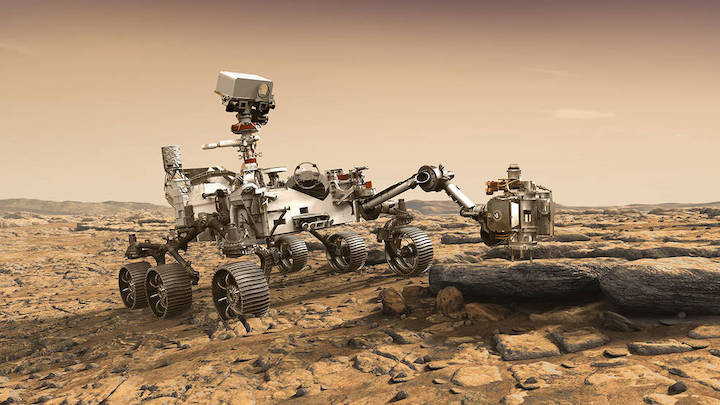
Media accreditation is open for the launch of NASA’s Mars 2020 Perseverance rover, designed to better understand the geology of Mars and seek signs of ancient life on the Red Planet.
The mission will use the robotic scientist, which weighs just under 2,300 pounds and is the size of a small car, to collect and store a set of rock and soil samples that could be returned to Earth by future Mars Sample Return missions. It also will test new technology to benefit future robotic and human exploration of Mars.
Perseverance will launch on a United Launch Alliance Atlas V 541 rocket from Space Launch Complex 41 at Cape Canaveral Air Force Station in Florida. The launch of Perseverance is scheduled for 9:15 a.m. EDT July 17 and is managed by NASA’s Launch Services Program. Live coverage of the launch will air on NASA TV and the agency’s website.
Due to the ongoing coronavirus (COVID-19) pandemic, NASA will be credentialing a limited number of media to cover the Mars 2020 launch from the agency’s Kennedy Space Center in Florida. Due to COVID-19 safety restrictions at Kennedy and quarantine requirements, international media who would be coming from overseas will not be able to register for this launch. International media already based in the U.S. may apply.
Media accreditation deadlines are as follows:
- U.S. media must apply by 4 p.m. EDT Sunday, June 28
- International media already in the U.S. must apply by 4 p.m. EDT Tuesday, June 9
All media accreditation requests should be submitted online at:
NASA is proactively monitoring the coronavirus (COVID-19) situation as it evolves. The agency will continue to follow guidance from the Centers for Disease Control and Prevention and the agency’s chief health and medical officer and communicate any updates that may impact mission planning or media access, as they become available.
For questions about accreditation, please email ksc-media-accreditat@mail.nasa.gov. For other questions, contact Kennedy’s newsroom at 321-867-2468.
Reporters with special logistics requests for Kennedy, such as space for satellite trucks, trailers, tents, electrical connections, or work spaces, must contact Tiffany Fairley at tiffany.l.fairley@nasa.gov by Sunday, June 28.
The Perseverance rover was built at NASA’s Jet Propulsion Laboratory in Southern California.
The Mars 2020 mission is part of NASA’s larger Moon to Mars exploration approach that includes missions to the Moon as a way to prepare for human exploration of the Red Planet. Charged with landing the first woman and the next man on the Moon by 2024, NASA will establish a sustained human presence on and around the Moon by 2028 through NASA's Artemis program.
Quelle: NASA
----
Update: 14.06.2020
.
After crane problem, ULA caps build-up of Atlas 5 rocket for Mars rover launch
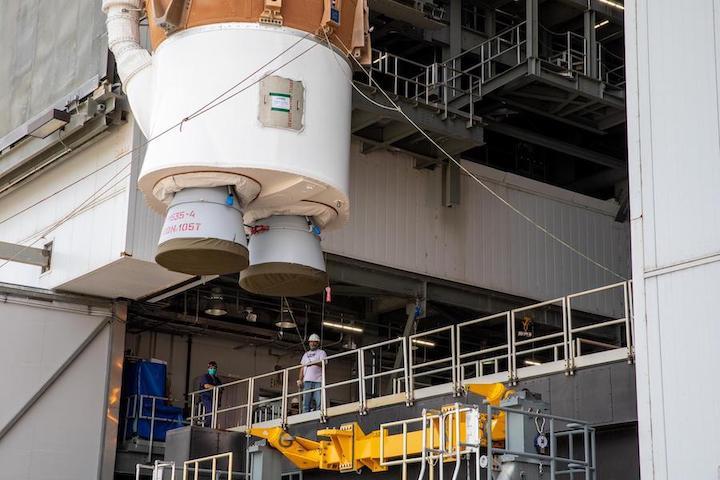
United Launch Alliance completed stacking of the major elements of the Atlas 5 rocket assigned to power NASA’s Perseverance rover toward Mars, but the mission’s launch date has been pushed back three days to July 20 after teams repaired an issue with a crane in the Atlas 5’s assembly building.
NASA said ULA needed the extra time to repair an issue with ground system equipment associated with the Atlas 5 rocket.
Tory Bruno, ULA’s president and CEO, wrote on Twitter that the issue was a “controller fault” on a crane at Cape Canaveral. ULA uses a crane to hoist rocket components inside the Atlas 5’s Vertical Integration Facility, located a quarter-mile south of the Atlas 5’s seaside launch pad at Complex 41.
The launch of NASA’s Perseverance Mars rover was previously scheduled for July 17, the opening of a 26-day launch window to enable the robotic spacecraft to travel directly on a seven-month journey from Earth to Mars. NASA and ULA recently assessed the performance of the Atlas 5 rocket and the final mass of the spacecraft, engineers determined they could add six days to the launch period to close Aug. 11.
“We’re moving the launch over by three days to the 20th,” said Thomas Zurbuchen, associate administrator of NASA’s science mission directorate. “We, of course, have a long window ahead of us.”
There’s a two-hour launch window available July 20 opening at 9:15 a.m. EDT (1315 GMT), according to NASA.
If the Perseverance mission misses its launch opportunity this year, the next chance to launch the mission won’t come until 2022. NASA prioritized the continuation of launch preparations for the Perseverance rover amid the coronavirus pandemic, even as other missions faced delays.
The agency says a two-year delay in the rover’s launch would add some $500 million to the mission’s cost, which is already more than $2 billion.

Stacking of the Atlas 5 rocket — tail number AV-088 — began May 28 with the hoisting of the first stage vertical on top of the Atlas mobile launch platform inside the VIF.
The Atlas 5 for the Perseverance rover mission will fly in the “541” configuration with four strap-on solid rocket boosters and a 17.7-foot-diameter (5.4-meter) diameter payload fairing. It’s the same Atlas 5 configuration used to launch the Curiosity rover in 2011.
The Perseverance rover is based on the Curiosity design, but it features several technology upgrades and a new suite of scientific instruments. One of the prime goals of the Perseverance mission is the collection of rock core samples inside small cigar-shaped tubes for retrieval by a future rover for return to Earth.
ULA completed stacking of the four solid-fueled boosters after raising the first stage inside the rocket’s vertical hangar. The solid-fueled motors, already packed with propellant, were manufactured by Aerojet Rocketdyne.
The Atlas 5’s Centaur upper stage, which will propel the rover on an escape trajectory away from Earth, was stacked on top of the rocket Wednesday, June 10. The Centaur stage, with a single Aerojet Rocketdyne RL10 engine, was integrated with the Atlas 5’s interstage adapter and the lower half of the rocket’s payload fairing in a nearby processing facility at Cape Canaveral before its move to the VIF this week.

ULA will roll the Atlas 5 rocket out to pad 41 later this month for a fueling test. ULA performs such fueling demonstrations before launches with limited planetary launch windows to ensure teams can detect and resolve any problems one the rocket before launch day.
The Atlas 5 will return to the VIF after the tanking test for attachment of the Perseverance rover, which will be encapsulated inside the Atlas 5’s payload shroud in the coming weeks inside the Payload Hazardous Servicing Facility clean room at the Kennedy Space Center.
The Multi-Mission Radioisotope Thermoelectric Generator, or MMRTG, is the rover’s nuclear power source. It will be connected with the rover once the spacecraft is already mounted on top of the Atlas 5 launcher inside the VIF.
The MMRTG converts heat from the radioactive decay of plutonium into electricity. Provided by the U.S. Department of Energy, the power generator is one of the final items installed on the rover in the final weeks before launch.
The Atlas 5 rocket is the only launch vehicle currently certified by NASA to carry nuclear-powered payloads into space.
After launching this summer, the Perseverance rover is scheduled to land Feb. 18, 2021, on Mars in a region named Jezero crater, the site of a dried-up river delta where scientists hope to find signatures of ancient life.
Quelle: SN
----
Update: 17.06.2020
.
NASA leadership and a panel of scientists and engineers will preview NASA's next mission to the Red Planet, the Mars 2020 Perseverance rover, at a media briefing at 2 p.m. EDT Wednesday, June 17. The live briefing will stream on Facebook, Ustream, YouTube, Twitter, NASA Television and the agency's website.
Perseverance is a robotic scientist weighing just under 2,300 pounds (1,043 kilograms). The rover's astrobiology mission will search for signs of past microbial life on Mars, characterize the planet's climate and geology, collect rock and soil samples for future return to Earth, and pave the way for human exploration of the Red Planet.
Briefing participants will be:
- NASA Administrator Jim Bridenstine
- Lori Glaze, director of NASA's Planetary Science Division at NASA Headquarters in Washington
- Katie Stack Morgan, Perseverance deputy project scientist at NASA’s Jet Propulsion Laboratory (JPL) in Southern California
- Matt Wallace, Perseverance deputy project manager at JPL
- Luis Dominguez, Perseverance deputy electrical integration and test lead at JPL
- Omar Baez, launch director in NASA’s Launch Services Program at NASA’s Kennedy Space Center in Florida.
To participate in the call, media must RSVP by noon Tuesday, June 16, to Rexana Vizza or Mark Petrovich of JPL's Digital News and Media Office at rexana.v.vizza@jpl.nasa.gov or mark.petrovich@jpl.nasa.gov or call 818-354-5011. Valid media credentials are required. Media and the public also may ask questions on social media during the briefing using #AskNASA.
The mission is scheduled to launch from Space Launch Complex 41 at Cape Canaveral Air Force Station in Florida at 9:15 a.m. EDT (6:15 a.m. PDT) July 20. The launch is managed by NASA's Launch Services Program. It will land at Mars' Jezero Crater on Feb. 18, 2021.
Quelle: NASA
----
Update: 19.06.2020
.
NASA prepares to launch Perseverance rover seeking signs of ancient life on Mars
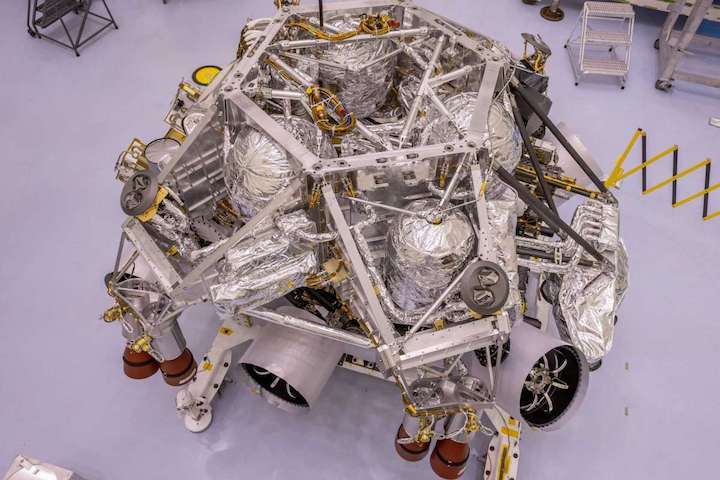
This image of the rocket-powered descent stage sitting on top of NASA's Perseverance rover was taken in a clean room at Kennedy Space Center on April 29, 2020.
NASA’s Perseverance rover will land on the surface of Mars in eight months with “ruggedized” camera eyes, microphone ears and a cutting-edge arm.
For the first time, cameras will capture high-definition video of a vehicle landing on another planet. Its microphones will capture the sounds of wind and Perseverance’s wheels rolling along the Martian surface. And a drill located on the big robotic arm will capture rock and soil samples that, when returned to earth a decade later, could help scientists find signs of ancient life on another planet.
Oh, and don’t forget its wings — a small helicopter accompanying the rover is set to have the first powered flight on another planet.
“Perseverance is the most sophisticated mission we’ve ever sent to the Red Planet’s surface,” said Lori Glaze, the director of NASA's Planetary Science Division.
On Wednesday, Glaze and other NASA officials held a news conference to discuss the Mars 2020 mission and its Perseverance rover slated to launch July 20 at 8:15 a.m. CDT from Cape Canaveral Air Force Station.
Riding on a United Launch Alliance Atlas V rocket, the rover has a three-week window that allows for a direct path to Mars as both planets are aligned on the same side of the sun. If the rover is not launched by Aug. 11 (though there’s potentially some wiggle room until Aug. 15), Perseverance will have to wait another 26 months for the next launch opportunity. That’s why the Mars 2020 mission remained a top priority for NASA during the COVID-19 pandemic. Perseverance continued receiving hands-on work from a limited team while other programs were put on hold.
“It’s very expensive if we have to take Perseverance and put it back into storage for a period of two years,” said NASA Administrator Jim Bridenstine. “It could cost half a billion dollars.”
That’s a cost officials expect to avoid (they’ve already spent $2.4 billion to develop the rover and will spend another $300 million after it’s launched to operate it) as they remained confident the rover would launch this summer and then land in the Jezero Crater of Mars on Feb. 18, 2021.
This crater was chosen because it has one of Mars’ best-preserved deltas, which was formed when a river entered an open body of water and deposited rock, sand and potentially organic carbon. Perseverance will search this delta for biosignatures — patterns, textures or substances that require the influence of life to form, said Katie Stack Morgan, Perseverance’s deputy project scientist at NASA’s Jet Propulsion Laboratory California.
“We don’t know for sure what biosignatures on Mars are going to look like,” she said, “but we can look to our own Earth rock record to give us an example of what we might expect to find.”
And while the crater’s geological features are great for scientists, Jezero’s rocks, cliffs and hills will make it challenging to land, said Matt Wallace, Perseverance’s deputy project manager at the Jet Propulsion Laboratory. Landing is a task the spacecraft must do autonomously.
There is a 10-minute communications lag (one way) between Earth and Mars, and it takes just seven minutes from entering the outer atmosphere of Mars to landing on its surface. This is dubbed “the seven minutes of terror” because there is no interaction with the spacecraft during that time. Rather, the vehicle will take photos of the Martian surface during its descent and use an onboard computer system to figure out its position in the crater relative to hazards and then divert itself away from those hazards, Wallace said.
Once it’s on the surface — and NASA personnel have had a moment to celebrate — Perseverance will use its seven instruments to search for signs of ancient life, test new technologies and collect data that could inform future human missions to the Red Planet. The mission is expected to last at least one Mars year, which is 687 Earth days.
One instrument will take carbon dioxide from the Martian atmosphere and turn it into oxygen, which could be used on future missions for life support or fuel. Another instrument will measure pressure, temperature and humidity — all information astronauts would need to live and work safely on the planet.
But the rover’s drill is getting the most buzz. Perseverance will collect rock and soil samples with potential biosignatures, things worthy of studying in a lab on Earth to determine if they’re signs of past life on Mars, and leave them in “caches” on the planet’s surface. Plans for collecting these samples are still being worked out, but Glaze said another rover could launch from Earth in 2026 and travel to Mars to collect those samples. That second rover would bring those samples to a rocket that launches into Mars’ orbit and rendezvous with yet another vehicle that returns the rocks and dirt to Earth in 2031. NASA would partner with the European Space Agency to bring these samples home.
“Samples from Mars have the potential to profoundly change our understanding of the origin, evolution and distribution of life on Earth and elsewhere in the solar system,” Glaze said.
Designing Perseverance to collect those samples, the first step in this decade-long journey, was not easy. Wallace said one particular challenge was ensuring contamination from Earth wasn’t accidentally carried to Mars, where it could interfere with researchers’ hunt for trace chemical signatures that are billions of years old.
“This is probably the cleanest system that we’ve ever launched to Mars,” Wallace said.
Another Mars 2020 component garnering attention is the helicopter, named Ingenuity, that is traveling to Mars with the Perseverance rover. This small helicopter, weighing just 4 pounds (compared to Perseverance’s 2,260 pounds), will test flying technologies in the thin Martian air. On Mars, where the gravity is about one-third of Earth’s gravity but the atmosphere is just 1 percent as thick, it’s harder for a vehicle to generate lift. To make the helicopter light enough to take off, its computer, electronics and other components have been miniaturized.
Future missions could use helicopters to survey the terrain from above. And in the more distant future, helicopters might help astronauts explore the planet.
Quelle: Houston Chronicle
----
Update: 25.06.2020
.
Launch of NASA’s Perseverance Mars rover delayed to July 22
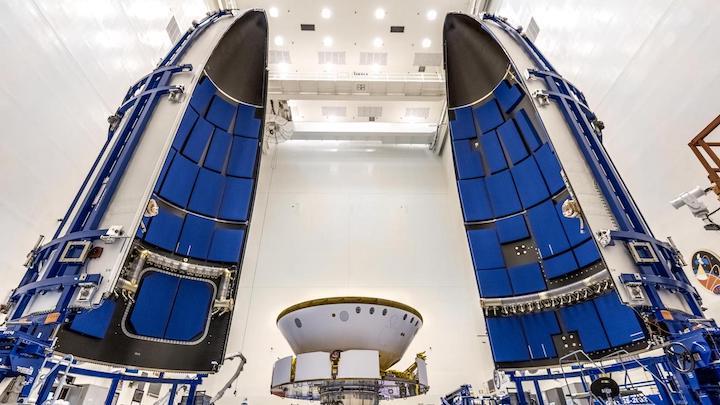
The launch of NASA’s Perseverance Mars rover and Ingenuity Mars Helicopter has been delayed two days to July 22 after an issue with ground support equipment at the Kennedy Space Center held up encapsulation of the spacecraft inside the payload fairing of its Atlas 5 rocket.
NASA said officials set a new target launch date for the Mars 2020 mission of July 22 “due to a processing delay encountered during encapsulation activities of the spacecraft.”
There is a two-hour launch window July 22 opening at 9:35 a.m. EDT (1335 GMT). NASA says the mission has until Aug. 11 to launch this year and still reach Mars on a direct seven-month journey, but officials are discussing extending the launch period a few additional days.
“Additional time was needed to resolve a contamination concern in the ground support lines in NASA’s Payload Hazardous Servicing Facility (PHSF),” NASA said in a brief statement Wednesday.
NASA said the spacecraft and launch vehicle are healthy, and encapsulation of the rover is being completed this week inside the PHSF, a climate-controlled clean room where NASA has prepared numerous interplanetary missions for launch.
Mary MacLaughlin, a NASA spokesperson, said Wednesday that the Perseverance rover and launch shroud will be mounted on top of their United Launch Alliance Atlas 5 rocket Saturday inside ULA’s Vertical Integration Facility near the southern perimeter of pad 41 at Cape Canaveral Air Force Station. That will kick off a series of connectivity and interface tests to ensure good data links between the Atlas 5 and the Mars 2020 spacecraft.
ULA teams completed a countdown rehearsal on the Atlas 5 rocket — without its Mars-bound payload — Monday at Cape Canaveral. The launch team loaded kerosene, liquid hydrogen and liquid oxygen propellants into the Atlas first stage and the Centaur upper stage, and halted the simulated countdown just before ignition of the Atlas 5’s RD-180 main engine.
ULA returned the rocket to the VIF from pad 41 Wednesday to ready the launcher for the arrival of the Perseverance rover.
In the final weeks before launch, ground crews will install the Perseverance rover’s plutonium-fueled power source through a port in the side of the Atlas 5’s payload fairing.
The Mars rover — about the size of a small car — will be powered by the Multi-Mission Radioisotope Thermoelectric Generator, or MMRTG, throughout its mission.
Built at NASA’s Jet Propulsion Laboratory, Perseverance was enclosed within its entry, descent and landing capsule in recent weeks at the Kennedy Space Center. The 1.6-foot-tall (49-centimeter) Ingenuity helicopter, set to become the first aerial vehicle of its type to fly in the atmosphere of another planet, is attached to the belly of the Perseverance rover for the trip to the Martian surface.
Perseverance and Ingenuity are mounted to a rocket-powered descent stage that will set the rover on the Martian surface using a tether. Landing is scheduled for Feb. 18, 2021, and mission managers say the Perseverance rover will attempt the most precise touchdown ever on Mars.
Perseverance carries a cluster of scientific instruments and 25 cameras to explore a region of Mars called Jezero crater, which is home to an ancient dried-up river delta.
The rover will also collect rock core samples for eventual return to Earth on a future mission. Scientists will search for the signatures of ancient life in the rock specimens that come back to Earth.
NASA’s new rover will collect martian rocks—and clues to planet’s ancient climate
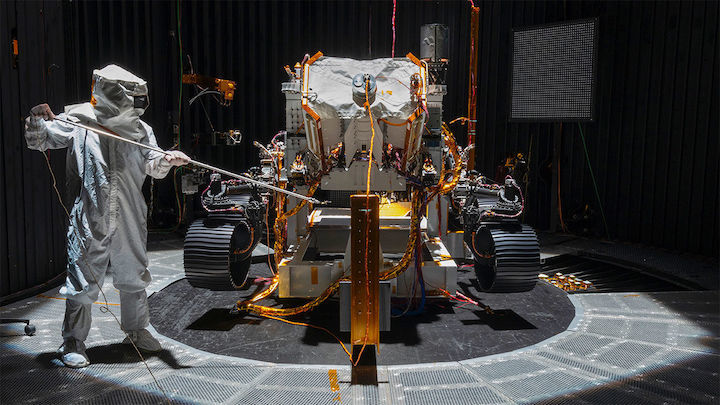
Perseverance is thermally tested in artificial sunlight. It will explore more than 500 million years of martian climate.
NASA/JPL-CALTECH
NASA’s newest Mars rover, Perseverance, is going back in time to the bottom of a vanished lake. If all goes well, in February 2021 it will land in Jezero crater and pop the dust covers off its camera lenses. Towering in front of it, in all likelihood, will be a 60-meter cliff of mudstone: the edge of a fossilized river delta. These lithified martian sediments could hold answers to urgent questions about the earliest days of Earth’s chilly, parched neighbor: How did this pintsize planet, so distant from a faint young Sun, support liquid water on its surface? How much water was there, and how long did it persist? And did Mars ever spawn life?
The 45-kilometer-wide crater is an intriguing target. Billions of years ago, when life was just beginning on Earth, water broke through its western rim and spilled into its interior, carrying sediments that settled and piled up in thick, meandering braids that today can be seen from space, as plain as day. “It’s kind of like the Mississippi delta, but smaller,” says Raymond Arvidson, a planetary geologist at Washington University in St. Louis. The water filled the crater like a bathtub until, 250 meters deep, it breached the eastern rim. And then, just as mysteriously as it arrived, the water disappeared.
Scientists have traced the tracks of ancient water across Mars ever since the 1970s, when orbiters revealed branching valley networks that matched the dendritic shape of water-eroded valleys on Earth. In the 1990s, the Mars Global Surveyor zoomed in on deeply incised gullies that could only have been carved by powerful flows of water—and may even have glimpsed shorelines from an ancient ocean. Later orbiters found evidence of abundant clay-bearing minerals that need water to form. More recently, the Curiosity rover, Perseverance’s predecessor, has charted the existence of a long-lived lake at the bottom of its adopted home, Gale crater.
Some scientists believe the water shows ancient Mars was warm for millions of years, a favorable climate for life to emerge. Others say the climate was cold and dry, punctuated by sporadic bursts of water that only lasted for hundreds or thousands of years—a much more difficult environment for life to take root. Along with the question of past life, says Ken Farley, the mission’s project scientist and a geologist at the California Institute of Technology (Caltech), Mars’s ancient climate “is the biggest unanswered question.”
Perseverance will tackle both questions, although the search for life will take longer. The rover, developed by NASA’s Jet Propulsion Laboratory (JPL) and set for launch next month from Cape Canaveral Air Force Station in Florida, is also the start of an audacious campaign that will ferry to Earth about 30 samples of martian rock and grit. Perseverance will gather the samples, and NASA and the European Space Agency (ESA) are designing two follow-up missions to retrieve them, aiming for launches in 2026.
The complex mechanisms needed to drill and store these cores limited the room on board for tools to chemically analyze samples and look for organic molecules. Until the samples reach labs on Earth, the question of whether life once existed in Jezero will probably go unanswered. “We’ll have to be patient,” says Tanja Bosak, a geobiologist at the Massachusetts Institute of Technology and member of the rover’s science team.
The story of the martian climate, on the other hand, will be etched across Jezero’s surface, visible to an array of rover instruments. Scientists can only make a rough guess at the lake’s age, but they think it formed 3.8 billion years ago, about the same time as the valley networks, over hundreds or thousands of years. Unlike Curiosity’s target, Gale crater, which offers a snapshot of a moment some 3.5 billion years ago when Mars was likely drying out, Jezero and its surroundings will grant access to more than 500 million years of martian history, including some of the planet’s oldest terrain, says Bethany Ehlmann, a Caltech planetary scientist and member of the science team. “We have the potential for a really rich history of climate.”
BY DESIGN, PERSEVERANCE borrows much from Curiosity: a six-wheeled chassis the size of a small SUV, an imaging turret, a radioisotope power source. “From the outside it looks the same,” says Allen Chen, one of the rover’s lead engineers at JPL. “But it’s got it where it counts.” That includes advanced new imaging instruments, landing capabilities, and a complex drilling system—innovations that led its budget, originally pitched as a bargain at $1.5 billion, to balloon and end up matching Curiosity’s $2.7 billion price tag, which includes operations.
To analyze samples in its onboard lab, Curiosity’s drill only needed to pulverize rock. Perseverance, in contrast, must drill intact cores, each about the size of a thick piece of school chalk, and store them within titanium tubes. The system also has to keep the cores safe and clean, to prevent Earthborne microbes and molecules from being mistaken for martian ones when the cores finally arrive back on Earth. In the end, engineers dreamed up a system involving two robotic arms, nine drill bits, 43 sample tubes, and a rotating carousel. “When you look at it, you won’t think of it being simple,” says Adam Steltzner, the rover’s chief engineer at JPL, “but it was the simplest we could imagine.”
Building and testing that system nearly delayed a mission straining to meet tight deadlines. In October 2019, engineers discovered the tubes seized up inside the drill bit when tested in martian conditions. “For me it was a moment of despair,” Farley says. “How were we ever going to fix this?”
The problem, it turned out, was that the rover was too clean. The tubes had been baked at 350°C for 1 hour, which not only sterilized them, but also vaporized a hydrocarbon film. The team hadn’t realized that the film, a patina that forms on nearly any metal exposed to Earth’s atmosphere, was needed as a grease. After several stressful months, they developed a cleaning routine that limited the baking to 150°C and included a series of chemical washes. That left a small amount of the film on the outside of the tubes but no trace inside, where it might contaminate samples. “We leave nothing behind, like a good hiker,” Steltzner says.
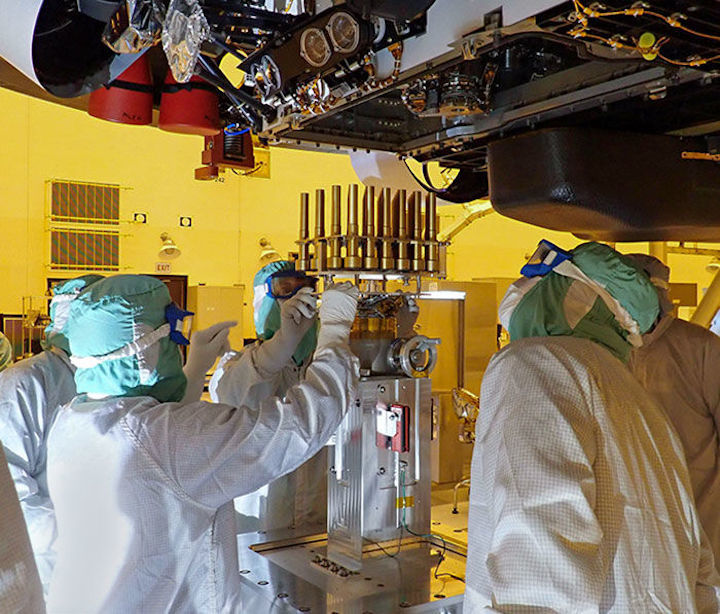
Sample tubes, baked and washed clean of microbes, were the last rover parts installed. NASA aims to return about 30 to Earth.
After the issue was resolved, another mote of organic material began to threaten the mission’s launch. By February, the coronavirus pandemic had postponed the launch of ESA’s Rosalind Franklin rover, which already had parachute problems, until 2022, the next Mars launch window. Determined to hit its window, NASA shuttled a skeleton crew to and from Florida for the rover’s final inspections, while most JPL engineers did what they could from their California homes. “It’s fascinating how much of it you can do from your living room,” says Jennifer Trosper, the rover’s deputy project manager for surface operations. “We’re used to remote operation. We just had to move it back a little earlier.”
In May, with the rover already stacked on the spacecraft that would ferry it to Mars, a C-130 transport plane delivered the cleaned sample tubes, quarantined in nitrogen-filled cases, to Cape Canaveral. Engineers loaded the tubes just before a heat shield sealed the rover within its landing capsule. A last-minute arrival of the tubes was always the plan to limit contamination risks. Also, Trosper adds, “We just finished them.”
On 22 July, a 3-week launch window opens up. Seven months after an Atlas V rocket puts it on a path to Mars, the rover will plunge through the barely there martian atmosphere. Just as for Curiosity, a “sky crane” hovering on retrorockets will unspool Perseverance on a tether and lower it to the ground. But there’s an important improvement: A camera on the rover’s belly will assess the landscape as it descends and compare it to a stored map of safe landing spots. The sky crane will fire its thrusters to divert to one of these zones, enabling the rover to land far closer to its target than Curiosity did in 2012, in a nearly circular, 8-kilometer-wide landing ellipse at the delta’s edge.
FROM THAT MOMENT it will be a player in what Nature Geoscience dubbed a “war” over Mars’s ancient climate. What Curiosity saw at Gale crater convinced some geologists that ancient Mars remained warm for millions of years. Sediments probably built up more slowly on Mars than on Earth, so the thick sediments at Gale suggested “this lake almost certainly existed for tens of millions of years, maybe longer,” says John Grotzinger, the Caltech geologist who led Curiosity’s science for its first few years.
If so, the lake would have endured climate variations driven by chaotic wobbles in the planet’s tilt, which varies from 10° to 60°. Something must have kept the planet warm while the lake shifted between tropical and arctic latitudes. “Did we land in one weirdo place on Mars? Probably not,” Grotzinger says. But what warmed the climate is a mystery, he admits. “Something is missing, and we don’t know what that is yet.”
To the opposing camp, that’s grounds for skepticism about a warm early Mars. In 1991, James Kasting, a planetary scientist at Pennsylvania State University, University Park, reported that an atmosphere of carbon dioxide (CO2) and water vapor, both greenhouse gases, was not capable of keeping the ancient planet wet and warm for millions of years. The atmosphere would have been too thin, and the early Sun too weak. Mars “must have had a phenomenal greenhouse effect,” Arvidson says, double what exists now on Earth. To this day, even with more sophisticated models, “The climatologists haven’t figured out how to do it,” he adds.
That has led these scientists to argue that martian water flowed in bursts lasting just thousands of years—brief exclamations in an eternal deep freeze. That is a Mars that climate models can simulate, says Robin Wordsworth, a planetary scientist at Harvard University. Its ancient volcanoes could have belched a lot of hydrogen, a strong but short-lived greenhouse gas. Periodic bursts of water could have rusted iron-bearing minerals, releasing more hydrogen to the air. Or asteroid strikes, more common in that era, could have released hydrogen if they hit regions rich in ice or subsurface water. “For all of them you can make episodic warming work,” Wordsworth says. “But not warm and wet.”
The rocks in Gale crater can also support this view, Ehlmann says. They lack certain minerals that should be present if they were exposed to water for 1 million years or more. Jim Bell, a planetary scientist at Arizona State University, Tempe, has concluded that ancient Mars was probably like Antarctica, icy and dry, with spurts of melt. “More Earth-like does not mean like most of the Earth.”
PERSEVERANCE WILL NEED the head start provided by a precise landing to try to settle the issue. During its 2-year primary mission, it will take advantage of upgraded wheels and autonomous navigation capabilities to briskly traverse more than 15 kilometers—a distance Curiosity took more than 4 years to cover. The rover will collect its first 20 samples for an eventual return mission from the geologically diverse terrain it will cross.
The first samples are likely to be rocks thought to come from an eruption that covered parts of the crater after the lake dried up. Volcanic rocks contain trace radioactive elements that decay at a certain rate, a clock that lab scientists on Earth can use to date the eruption, putting a lower limit on the age of the lake. Mission scientists also hope to find outcrops of older volcanic rocks that sit below the delta mudstones, marking an eruption that occurred before the water arrived. Those would provide an upper age limit, making it possible to roughly bracket the lake’s existence. “When were these habitable environments in absolute time, and how quickly did they come and go?” Ehlmann asks.
As the rover rolls along the lake bottom, a ground-penetrating radar mounted on its belly will fire, recording echoes that reveal the textures of sediment up to 10 meters below the surface. “We’ll be creating a giant ribbon of data,” says David Paige, a planetary scientist at the University of California, Los Angeles, and the instrument’s deputy principal investigator. The reflections could help determine whether the lake was open water or covered in ice. Fine mud would suggest open water; anomalously large stones would suggest ice, which could have carried them to the middle of the lake before dropping them.
From there the rover will visit the fine-grained clay-bearing mudstones of the lower parts of the delta. Here the hunt for past life will take the lead. On Earth, such clays blanket living things and preserve them as fossils. In similar clays at Gale crater, Curiosity scientists detected traces of complex organic compounds that resembled kerogen, the feedstock of oil. But they could not determine whether the compounds, detected at levels of a few dozen parts per million, were produced by ancient life, or deposited on the martian surface by meteorites, which often contain complex organic molecules.
Two instruments mounted at the end of Perseverance’s main robotic arm may help tell the difference. One will fire an ultraviolet laser at the rocks; the other will bombard them with x-rays. The radiation re-emitted by atoms in the rocks could reveal organic chemistry. Mapping any organics in a rock could also say something about their origin. A uniform signal would favor meteoritic fallout, whereas a lumpier distribution, and the presence of minerals that hint at microbe-fueling reactions, could be a sign of life—and a green light to drill a sample.
As the rover forges a path up the delta, the fine mudstone will give way to rough sandstone. The team will keep an eye out for exposures of opal-like rocks that have recently been spotted from space. Opal forms from a solution of silica and water, and on Earth the deposits are classic fossil-hunting spots. That’s because the mineral creeps into organic layers and preserves fossil structures, Bosak says. “That’s where we find the most beautifully preserved microbial mats.” The rover’s cameras will search for such structures, but Bosak doubts they will be seen—even on Earth, they are not often apparent until polished in the lab.
The sand grains, washed in by the long-lost river, could also say something about what caused Mars’s early warmth—whether steady or intermittent—to dissipate after the delta formed. Some of the sand grains, eroded from volcanic rocks, will contain radioactive isotopes that make it possible to date them. Scientists on Earth will also examine certain minerals to look for the frozen imprint of a magnetic field. Mars is believed to have had a magnetic field early in its history, generated by a molten dynamo in the planet’s interior. The field would have failed as the dynamo cooled and shut down, and some believe that explains Mars’s radical change in climate. A weakening field could have allowed charged particles from the Sun to erode the planet’s once-thick atmosphere. Water would have escaped to space, making the planet colder and drier. Magnetic signatures teased out of the sand grains could show whether the decline of the field preceded—and perhaps caused—the climate change.
AFTER NEARLY 2 YEARS of frantic drilling, the rover will climb one of the delta’s fingers to reach the shores of Jezero’s paleolake, fast against the crater’s edge. Orbiters have spotted a bathtub ring of carbonate rocks running around the crater rim in a narrow band, likely where the lake’s warm shallows were. On Earth, such deposits are known to preserve fossilized stromatolites, bumpy cauliflowerlike mounds formed by the growth of bacteria. “They are an ideal place to look for past life,” says Briony Horgan, a planetary scientist at Purdue University. That is, she says, if the deposits were formed by the lake, and not by hot water created by the crater-forming impacts.
If the lake was responsible for the carbonate deposits, they will offer a window on the ancient martian atmosphere, which supplied the CO2 that formed them. By comparing carbon isotopes from carbonates in the bathtub ring and in older rocks outside the crater, scientists could learn how levels of atmospheric CO2—and the greenhouse effect it drives—changed over this time.
The outcrops around these shallows, near the entry point of the river, could also betray something about the climate at the time the delta was laid down, says Timothy Goudge, a planetary scientist at the University of Texas, Austin. Layering in the outcrops will reveal how much water was needed to form the delta, how long it flowed, and whether it came in the brief floods or steady flows. Cracks in river bottom rocks could be wedges opened up by continuous freeze-thaw cycles—a sign of persistent frigid conditions.
The shallows will likely mark the end of the primary mission. But the rover ought to have many more years left on its odometer. Engineers want the rover, while still healthy, to drop some samples on flat, accessible terrain where a later mission can retrieve them. But it may drill some sites twice, and it will continue to collect—in case the rover itself is healthy enough to deliver samples to the Earth return mission.
After the primary mission, many on the team will be eager to escape the delta for the ancient, mysterious terrain to the west. Deposits of clay and carbonate seen there also needed water to form. If bands of water-weathered rock capped by water-deposited sediments are visible on its mesas, a temperate climate may have prevailed. Alternatively, as Ehlmann and others believe, this landscape could be what’s left of an icy subsurface that was heated by nearby giant impacts 4 billion years ago and turned into an underground hydrothermal system capable of fostering life. “That would point to an ancient Mars that was habitable, but not so warm,” she says.
Whatever answers the rover finds, it will mark the end of an era on Mars. For decades, NASA has dominated exploration of the planet’s surface, culminating in the increasingly ambitious rovers of the past 2 decades. “We’ve had the privilege and responsibility to do a systematic investigation of a planet,” says Jim Watzin, director of NASA’s Mars Exploration Program. Other nations will soon add their rovers, starting with China this year.
But Perseverance also kicks off a new era. The sample return effort it anchors “will be the first round trip to another planet by humanity,” Watzin says. Bringing Mars to Earth will enable scientists to probe the secrets of the Red Planet more deeply. If humans follow in the rover’s tracks in the coming decades, as the United States and China have vowed, the terrain they encounter may seem strange. But it will be familiar ground.
Quelle: AAAS
----
Update: 29.06.2020
.
How NASA's Mars Helicopter Will Reach the Red Planet's Surface
The small craft will seek to prove that powered, controlled flight is possible on another planet. But just getting it onto the surface of Mars will take a whole lot of ingenuity.
NASA's Ingenuity Mars Helicopter will travel with the Perseverance rover through 314 million miles (505 million kilometers) of interplanetary space to get to Mars. But for the team working on the first experimental flight test on another planet, engineering the final 5 inches (13 centimeters) of the journey has been among the most challenging of all. To safely navigate those 5 inches - the distance Ingenuity will travel from where it's stowed on the rover to the surface of Mars - they came up with the ingenious Mars Helicopter Delivery System.
"Ingenuity is unlike any other helicopter ever built because powered controlled flight at Mars is unlike anything ever attempted," said MiMi Aung, project manager of the Mars Helicopter at NASA's Jet Propulsion Laboratory in Southern California. "And then we had to figure out how to hitch a ride and safely get deployed from the Mars 2020 Perseverance rover."
Ingenuity's square fuselage (which houses computers, cameras, batteries and the like) is about the size of a softball (7.9 by 6.3 by 5.5 inches, or 20 by 16 by 14 centimeters). But if you look outside the box, you'll find plenty of other important stuff - including an antenna, solar panel, landing legs and two rotors measuring 4 feet (1.2 meters) across - that makes stowing and deploying the helicopter a challenge. The entire package tips the scales at about 4 pounds (2 kilograms).
"On a Mars rover mission, the addition of even one new washer is usually worthy of debate," said Chris Salvo, the helicopter interface lead of the Mars 2020 mission at JPL. "The Ingenuity Mars Helicopter is a large, fragile, unique assemblage of hardware that is dissimilar to anything NASA has ever accommodated on a planetary mission."
Mission engineers considered every available parking space on the rover chassis for their unusual addition, including the robotic arm. They eventually landed on Perseverance's belly, which on a relatively flat stretch of Red Planet surface should offer about 26 inches (67 centimeters) of ground clearance. While that may seem like a lot of room (an Earthly SUV provides about a third of that), the delivery system reduces that distance by about 2 inches (6 centimeters). Ingenuity is about 19 inches (49 centimeters) tall. This is where the 5-inch journey comes in.
"That is not a lot of room to play with," said Salvo, "but we found if you attach the helicopter horizontally, there is enough to get the job done."
NASA's Ingenuity helicopter is traveling to Mars attached to the belly of the Perseverance rover and must safely detach to begin the first attempt at powered flight on another planet. Tests done at NASA's Jet Propulsion Laboratory and Lockheed Martin Space show the sequence of events that will bring the helicopter down to the Martian surface. Credit: NASA/JPL-Caltech and Lockheed Martin Space
How the Job Is Done
Ingenuity will be deployed about two months after Perseverance lands on Feb. 18, 2021. During early surface operations, both the rover and helicopter teams will be on the lookout for potential airfields - a 33-by-33-foot (10-by-10-meter) patch of Martian real estate that is comparatively flat, level, obstruction-free and viewable by Perseverance when the rover is parked about a football field away.
On around the 60th Martian day, or sol, of the mission, Perseverance will drop the Mars Helicopter Delivery System's graphite composite debris shield that protected the helicopter during landing. Then it will drive into the center of the chosen airfield. About six days late


